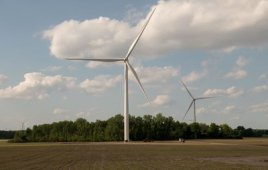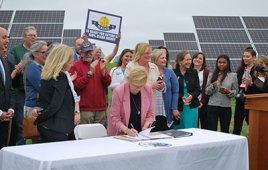David Friedman, Assistant secretary for Energy efficiency and Renewable Energy Acting
Clean energy technology costs are down – and deployment is up. So, you say you want a revolution? Well, you know, when it comes to clean energy, we are changing the world (with a hat tip to The Beatles).
Energy Secretary Ernest Moniz has announced an exciting update to the Energy Department’s Revolution…Now report, which highlights the dramatic growth and decreasing costs of five clean energy technologies: wind turbines, photovoltaic (PV) solar modules for both utility-scale plants and distributed systems, electric vehicles (EVs), and light-emitting diodes (LEDs).
As the report demonstrates, the Energy Department’s investments in clean energy technologies are paying off – and then some. Here are my three big takeaways from this year’s Revolution…Now report:
Commitment + innovation => Significant cost reductions
The report demonstrates that the Obama administration’s commitment to advancing clean energy through innovation has led to steep cost reductions. In just the past eight years, we have seen:
- A 94% decrease in the cost of A-type LED light bulbs.
- A 73% decrease in the cost of EV batteries.
- A 64% decrease in the cost of utility-scale solar PV.
- A 54% decrease in the cost of distributed solar PV.
- A 41% decrease in the cost of land-based wind power.

As the world continues to move toward a clean energy economy, our nation is already realizing the economic and environmental benefits of the increased deployment of these technologies.
Deployment keeps rising
As the world continues to move toward a clean energy economy, our nation is already realizing the economic and environmental benefits of the increased deployment of these technologies.
Total installations of LED light bulbs have more than doubled from last year to more than 200 million. Cumulative EV sales are about to pass the half-million mark, helping the United States emerge as one of the largest EV markets in the world.
Meanwhile, distributed solar PV systems have been installed on more than 1 million rooftops on U.S. homes and businesses, and utility-scale solar PV represents more than 15% of the newly installed generation capacity – enough to power 2 million homes. Land-based wind power now accounts for 41% of all new capacity brought online, which is enough to provide energy for nearly 17 million American households. Combined, wind and solar accounted for more than 66% of all new capacity installed in the nation in 2015.
More on the way
The highlighted technologies are increasingly visible across the country: wind towers dot the landscape, utility-scale and distributed solar installations are soaking up more sunlight than ever, LEDs are on every hardware shelf, and the latest EV models can be seen on many neighborhood streets.
Not only do these technologies reduce carbon emissions and help mitigate the worst effects of climate change, but they are increasingly more cost-competitive with existing technologies.
This revolution is also expanding economic opportunities for American workers and manufacturers. In 2014, the manufacturing sectors for wind turbines, PV solar panels, lithium-ion batteries, and LEDs have added $3.8 billion dollars in value to the U.S. economy.
Looking ahead to the future, we will continue to strategically invest in research and development. We will also partner with key stakeholders to reduce market barriers and accelerate more promising technology to commercialization. This includes emerging technologies that are on the cusp of wider deployment in the years ahead – grid-connected batteries, energy management systems, smart buildings, and big area additive manufacturing, commonly referred to as 3D printing. The report also highlights a number of emerging technologies that could hold major impact for the future of sustainable transportation, including fuel cells, vehicle lightweight materials, and super-efficient 18-wheeler trucks.
This century will be defined by advancements in clean energy innovation. As we compete with nations around the world, we are focused on maintaining our role as a leader in the global transition to a low carbon economy. The 2016 Revolution…Now report confirms that we’re well on our way.
Filed Under: Uncategorized





